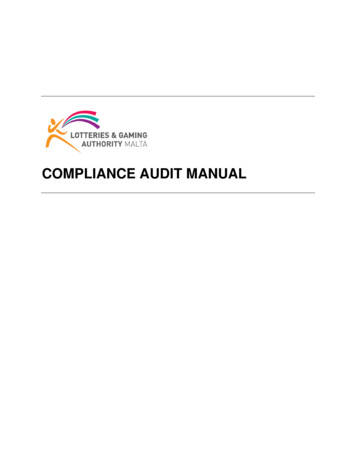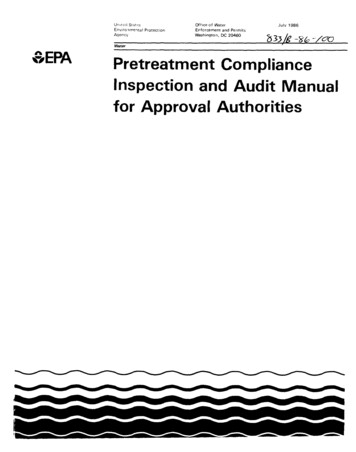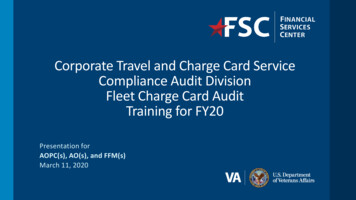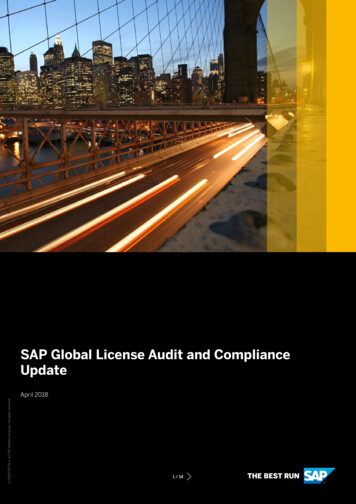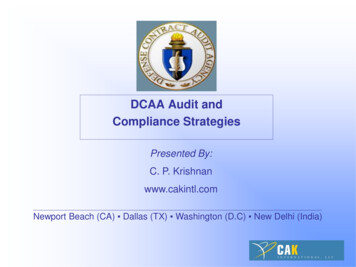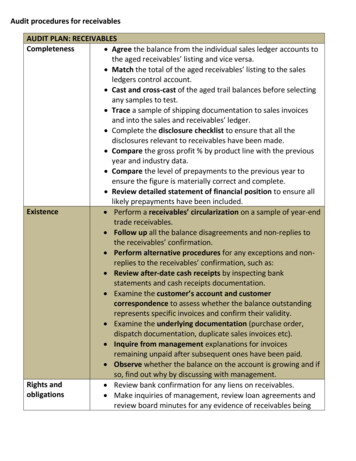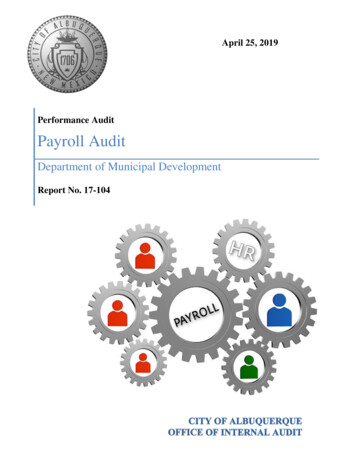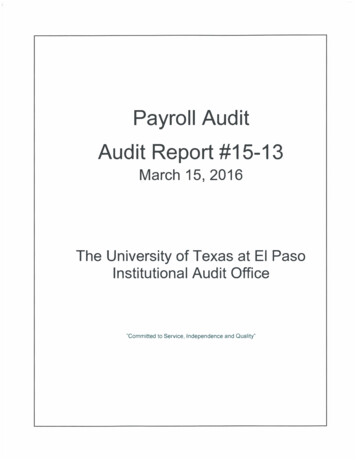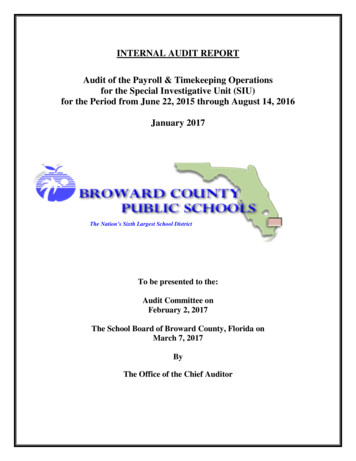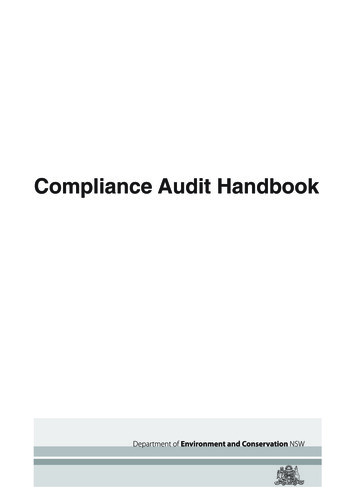
Transcription
Compliance Audit Handbook
This Compliance Audit Handbook has been produced by the Compliance and Assurance Section of theDepartment of Environment and Conservation NSW (DEC).For technical information on the matters discussed in the handbook, contact the DEC Compliance andAssurance Section on (02) 9995 5000.Published by:Department of Environment and Conservation NSW59–61 Goulburn Street, SydneyPO Box A290Sydney South, NSW 1232Phone: (02) 9995 5000 (switchboard)Phone: 131 555 (environment information and publications requests)Phone: 1300 361 967 (national parks information and publication requests)Fax: (02) 9995 5999TTY: (02) 9211 4723Email: info@environment.nsw.gov.auWebsite address: www.environment.nsw.gov.auDEC is pleased to allow this material to be reproduced in whole or in part, provided the meaning isunchanged and its source, publisher and authorship are acknowledged.DEC 2006/13ISBN 1 74137 787 0Original version: February 1997Revised: February 2006Printed on recycled paper
PrefacePurpose of this handbookThis handbook was prepared by the Department of Environment and Conservation NSW(DEC) as a guide for DEC officers undertaking compliance audits. A compliance audit is anassessment of an auditee’s activities to determine whether they comply with the relevantregulatory requirements.The handbook may also be used by other organisations undertaking compliance auditsincluding public authorities, industry and industry groups, professional associations,consultants and contractors; and as an educational resource by students.The handbook provides general procedures and protocols for conducting compliance audits.These are designed to ensure a consistent approach to audits, helping to ensure all audits areadequate, reliable and comparable.Although the handbook is designed for use as a standalone document, it is recommended thatit be used with the international standard adopted in Australia for environmental auditing:AS/NZS ISO 19011:2003, Guidelines for quality and/or environmental management systemsauditing (see References).This handbook has been prepared for the purpose described, and no responsibility is acceptedfor its use in any other context or for any other purpose.
ContentsPreface1 Introduction. 11.1 What is a compliance audit?. 11.2 What is an auditee?. 11.3 Compliance audit as a regulatory tool in DEC . 11.4 Objectives of the compliance audit . 11.5 Knowledge and skills of auditors. 22 DEC audit procedures . 32.1 The audit process . 32.2 Pre-site visit activities. 32.3 On-site activities. 72.4 Post-site visit activities . 93 Quality assurance and record keeping. 133.1 Quality assurance . 133.2 Record keeping. 13Glossary . 14Appendices. 15Appendix 1 Audit plan . 15Appendix 2 File record of site assessment . 17Appendix 3 Example of a risk assessment process . 18Appendix 4 Example of a quality plan. 19References . 20List of tablesTable 1: Audit activities . 3Table 2: Sample checklist format. 6Table 3: Compliance, non-compliance, not determined and not applicable assessments . 10Table 4: Regulatory review stages. 12Table 5: Records to be kept for filing . 13
1 Introduction1.1 What is a compliance audit?An audit is:‘a systematic, independent and documented verification process of objectively obtainingand evaluating audit evidence to determine whether specified criteria are met’.AS/NZS ISO 19011:2003, Guidelines for quality and environmental management systemsauditing (see References).The specified criteria in compliance audits conducted by the Department of Environmentand Conservation NSW (DEC) are generally the legal and regulatory requirements DECadministers.1.2 What is an auditee?An auditee is a person or organisation being audited. DEC audits organisations orindividuals whose activities are regulated by legislation DEC administers. DEC may audit,for example, industries operating under environment protection licences or individuals ororganisations holding permits relating to threatened species or Aboriginal objects andplaces.1.3 Compliance audit as a regulatory tool in DECDEC has responsibilities and powers under a range of NSW legislation including: environment protection legislation covering air and water quality, waste, contaminatedland, noise control, pesticides, hazardous chemicals, transport of dangerous goods,forestry and radiationconservation legislation protecting biodiversity and threatened specieslegislation protecting Aboriginal cultural heritage.DEC uses compliance audits as one of its regulatory tools, to assess the extent to which alicensee or other regulated entity is complying with its legal requirements, and to reviewachievable environmental standards.1.4 Objectives of the compliance auditCompliance audits in DEC are used to achieve the following objectives: maintaining the integrity of the regulatory system administered by DEC, ie, legislation,licences, notices, consentsensuring credible and robust regulationimproving compliance with legislative requirementsthrough public audit reporting, ensuring DEC’s regulatory activity is open andtransparentensuring that statutory instruments are robust and are appropriately used to achievedesired environmental and conservation outcomesensuring that environmental and conservation regulation across NSW is consistent andtransparent.Compliance Audit Handbook1
A DEC auditor will: assess compliance with environmental and conservation legislation. A DEC auditormay assess compliance with legislation and the statutory instruments administered byDEC. This may include assessing compliance with conditions attached to statutoryinstruments and the broader statutory requirements of various Acts and Regulations.review statutory instruments issued to the auditee. Activities that may have anenvironmental impact are examined to determine whether they are adequately covered bythe instruments. The DEC will review the quality of the instruments by assessing theirconditions or criteria for consistency, their legal enforceability, and their degree ofenvironmental, conservation or cultural heritage protection.report findings and follow-up action. A DEC auditor will report on the scope of the auditand document the assessment of compliance. A follow-up action program may beestablished to address non-compliance.Stakeholders’ awareness of environmental issues and their confidence in DEC’s regulatoryrole increase through DEC communicating and promoting audit findings. Stakeholders includethe community, industry and licensees.1.5 Knowledge and skills of auditorsAuditors should have the necessary knowledge and skills to apply audit principles,procedures and techniques when undertaking compliance audits. DEC has its own internalenvironmental auditor training program. A DEC officer who has undertaken the training andhas demonstrated that they have the required competencies to undertake compliance auditsis eligible for certification as a ‘Provisional Environmental Auditor’ with RABQSAInternational.The auditors will have the knowledge and ability to conduct audits in accordance with thishandbook and any other internal work procedures.DEC staff conducting compliance audits will act ethically, be objective and without bias, andbe versatile, open-minded and decisive.Compliance Audit Handbook2
2 DEC audit procedures2.1 The audit processThe audit process involves tasks that can be grouped into pre-site visit activities, on-siteactivities and post-site visit activities.Table 1: Audit activitiesActivityPre-site visit activitiesPlanning and preparing for the auditCollecting background informationCompiling checklistsOn-site activitiesConducting an opening meetingCollecting audit evidence through gathering information,observations and interviews, and samplingConducting a closing meetingPost-site visit activitiesEvaluating audit evidenceCompiling a compliance audit reportDeveloping a follow-up action programConducting a regulatory reviewMore informationsee 2.2.1see 2.2.2see 2.2.3see 2.3.1see 2.3.2see 2.3.3see 2.4.1see 2.4.2see 2.4.3see 2.4.4It is important to understand that an audit’s activities are not restricted to the site visit.Careful and thorough planning before conducting on-site activities and the post auditevaluation are just as critical to the audit’s success as the proper conduct of a siteinspection.2.2 Pre-site visit activitiesIn achieving a successful audit, the value of good planning and preparation cannot beoveremphasised. Proper planning should ensure that appropriate resources and equipmentare available and time is allocated to carry out the audit in the most efficient and effectiveway.2.2.1 Audit planning and preparationThe audit plan outlines the audit’s objectives, scope and timetable, and the products that theaudit will generate. See Appendix 1 for an example of an audit plan.An audit plan should include the following key elements: the audit objectivesthe audit criteria and any reference documentsthe audit scopea quality plan identifying reviews to be undertakenan assessment of logisticsCompliance Audit Handbook3
an audit timetableroles and responsibilities of audit team membersthe allocation of appropriate resources to critical areas of the audit.Audit objectivesThe objectives of each compliance audit or audit program must be established at the outsetto direct planning and establish the method for each compliance audit. The objectives definewhat the audit will achieve and can be based on various considerations such asmanagement priorities, or statutory and regulatory requirements.Audit criteriaThe audit criteria are defined requirements against which the auditor compares collectedaudit evidence. The criteria may include regulatory requirements, standards, guidelines orany other specified requirements.Scope of the auditThe scope defines the extent and boundaries of the audit such as locations; organisationalunits, activities and processes to be audited; and the time period covered by the audit(adapted from ISO 19011:2003 — see References).Quality planThe quality plan identifies the quality assurance procedures that will be undertaken duringthe audit, for example, ‘Ensure audit plan is reviewed by manager’. See Chapter 3 for moreinformation about the quality plan and Appendix 4 for an example.Logistics of conducting the auditEach audit must be assessed to determine whether there are any potential barriers to itbeing successfully carried out. The lead auditor should be aware of any occupational healthand safety requirements for entry to the site including quarantine requirements, whetherappropriate staff will be available or whether bad weather will significantly hamper theinspection. It may be difficult to be fully aware of all these factors, especially if the audit willbe carried out ‘unannounced’.The DEC Regional Officer responsible for the site or area will know about any basicrequirements for entry to a site or if there are any other routine operational procedures thatmay affect the inspection, eg, hours of operation are limited to weekdays.Audit timetableThe audit timetable should include the date and places where on-site activities will beconducted, and the expected time and duration of each activity including the openingmeeting, safety induction when necessary, site inspection and closing meeting.Selecting the audit team and roles of team membersThe lead auditor should determine whether other personnel should be involved in the auditprocess. Other DEC officers who have a working knowledge of the auditee should beinvolved in the process from the outset to help with audit planning, provide backgroundinformation and, if necessary, accompany the auditor on the inspection. Team membersmay assist with audit evaluations, comment on draft reports and provide input to the followup action required.Technical experts may be called in to provide specialist knowledge. They may accompanythe team on the audit inspection if required or be referred to when necessary.Compliance Audit Handbook4
The lead auditor should be fully knowledgeable of the audit scope and criteria, lead the siteinspection, be the main point of contact between the auditee and DEC, and ensure theoverall competence of the audit team.Allocating appropriate resourcesThe lead auditor needs to ensure DEC officers required for the audit are available on theday, and ensure that sufficient resources are made available for the audit to be undertaken.2.2.2 Collecting background informationThe purpose of collecting and reviewing background information is to assemble relevantinformation that can be used to meet the objectives of the compliance audit. The collectionand review will enable auditors to become familiar with the auditee’s operations, thestatutory requirements and other regulations or guidelines that may apply.The types of information that should be reviewed include: site details, such as maps and process descriptionsmain environmental issuestechnical information about the processes and operationsindustry best practice and relevant standardsoperating manuals, plans and procedurescompany environmental policies and guidelinesstatutory and other requirementsprevious audits and compliance historyevidence of past environmental performance, such as inspections and complaintssafety requirementscommunity concerns related to the premises, regional area or industry typethe auditee’s working language, and social and cultural characteristics.This information may be found in DEC files, reports such as DEC’s Environment Linereports, environmental impact statements, databases or registers, or on maps. It may alsobe necessary to refer to specialists to obtain specific or technical information about theauditee.2.2.3 Audit checklistsThe audit checklist assists auditors in conducting a thorough, systematic and consistentaudit. Checklists are used to guide on-site observations and help the auditor to assesswhether evidence meets audit criteria.It is important to remember that checklists are used to jog the auditor’s memory and do notrigidly dictate exactly what is to be audited.Compliance Audit Handbook5
To prepare checklists, the auditor should use a table similar to the example below.Table 2: Sample checklist formatCriteria/requirementInstruction/question1.1 Licensees whogenerate waste mustdetermine if thewastes are classifiedas ‘hazardouswastes’.How is waste generated on-site identified andclassified?1.2 The occupier ofany premises mustmaintain any controlequipment installedon the premises in anefficient condition.1.3 The licenseemust notify the DECof any incidentcausing orthreatening materialharm to theenvironment as soonas practicable afterthe incident hasoccurred.Audit notesDetermine if the licensee follows the relevantcriteria for identifying the specific listing orcharacteristics of hazardous wastes.Are records kept (view documents)?What control equipment is on the premises?Is control equipment inspected and maintainedregularly? How often? By whom?Are inspections/maintenance documented(view documents)?Have any such incidents occurred within thetime scope of the audit?Were these incidents reported to DEC?Are employees made aware of thisrequirement or do work procedures includeinformation about this requirement?The first column will list all the requirements the auditee legally needs to meet. The secondcolumn will provide the auditor with instructions to help them determine whether eachrequirement has been met. The final column will be left blank so notes can be taken duringthe audit.When developing a checklist, the lead auditor should consider the experience andknowledge of the auditor who will be using it, and also the environmental risks of the auditedpremises. This will enable the lead auditor to select the appropriate level of detail for thechecklist. Experienced auditors can use a checklist that consists of a list of all the topics tobe covered during the course of an audit and does not give details about how to undertakethe auditing of each one. Less experienced auditors should use a detailed checklist that listseverything they need to know and do. This allows inexperienced auditors to undertakeaudits with relatively little supervision from the lead auditor.Detailed checklists may be required when auditing a premises with high environmental risks.2.2.4 Providing prior notice of an auditGenerally, all DEC compliance audits are undertaken unannounced. However, when this isnot possible due to logistical reasons or specific circumstances, DEC may undertakeannounced audits. If prior notification of the audit is given, the purpose of the audit should bespecified along with the areas to be covered and any information requirements. This approachimproves the chances that appropriate site representatives will be present and that necessaryinformation will be available. Thus, announced audits have their advantages.Compliance Audit Handbook6
Unannounced audits, on the other hand, are more likely to reveal the plant's true operatingconditions, as they offer the ‘true’ snapshot of operations on the day of the audit. They areparticularly useful when there is reason to believe the site is not complying with legislativerequirements and there is a likelihood of environmental impact or harm occurring.For each individual audit or audit program, the auditor needs to determine if notificationcould affect the audit results, and if notice is given, how much is sufficient.2.3 On-site activities2.3.1 Opening meetingThe objectives of the opening meeting are to meet with the site manager or theirrepresentative and: explain and confirm the audit plan, outlining the objectives, scope and audit proceduresprovide a short summary of how the audit activities will be undertakenallow the site manager or their representative to ask questions.The opening meeting is an important part of the audit process and can set the tone for howthe audit will proceed. It is important to be professional and polite throughout the meeting.The following information should be conveyed: introduce the audit team and provide identification (ie, authorised officer identification)explain the purpose of the auditexplain the audit objectives, scope and criteria (this will help keep the inspection ontrack)explain the methods and procedures used to conduct the auditexplain the steps that will be taken when preparing the audit report, eg, ‘all auditevidence collected will be assessed, a draft report will be prepared and reviewedinternally, and the report will be sent to the auditee for comment before being finalised’agree to an audit timetable to enable the site manager or their representative to arrangefor appropriate personnel to be available during the inspectionensure that the resources and facilities needed by the audit team are availabledetermine safety, emergency and security procedures.2.3.2 Collecting audit evidenceAfter the opening meeting, the auditor can start collecting and recording audit information.Some information can be obtained while in the office (ie, viewing or photocopying records)and the rest can be obtained during the site inspection.The following tasks should be completed during the site inspection: gather information—take notes, ask open questions (you may wish to review the noteswith the interviewee at the conclusion)complete audit checklistsdocument any observed environmental/conservation issues which were not anticipatedduring the preparation of the audit checkliststake a photographic record—always inform the site manager or their representative ofyour intention of taking photographs during the auditCompliance Audit Handbook7
examine relevant documents, eg, monitoring records, written procedures, site plans,process diagramsobtain copies of any documents which may be useful.Conducting interviewsOne important way of collecting information is to interview site personnel. This allows theresults of observation and document review to be verified and enables the interviewee toexplain or clarify those results. Conversely, information collected during interviews needs tobe verified by supporting information from independent sources, such as observations andrecords.Checklists developed during audit planning (see 2.2.3) should be used to prepare for theinterview, but only as a starting point. An experienced auditor is often skilled enough tofollow the flow of the interview and need not feel restricted by the checklist.Auditors should also prepare questions in advance to keep the interview focused. Thetechnique and content need to be considered carefully before the audit inspection andshould be adapted to the person being interviewed. Ensure the right site representatives forthe questions being asked are being interviewed.Environmental samplingGenerally, it is not the auditor's role to carry out sampling. The auditee’s managementshould monitor the operation over a period of time and in accordance with the requirementsof the licences, permits, notices, consents, approvals and other documentation relating tothe site. If these monitoring results are not available or a single sample is not scientificallyvalid, the auditor should record those facts, not carry out sampling to correct the deficiency.However, if the facility being audited has limits on discharges, and a discharge is occurringand there is some uncertainty about the discharge’s quality, the auditor may decide to takea sample to determine compliance with the limit condition. In this case, the auditor mustcollect a sample that represents the condition being assessed and must collect it in amanner consistent with the collection, handling and preservation principles in AS/NZS5667.1:1998: Water quality – sampling – guidance on the design of sampling programs,sampling techniques and the preservation and handling of samples (or any updated version)(see References).Documentation verificationWhen auditing, it is often not possible, due to limited resources, to check every document orrecord. The auditor should consider how much documentation should be viewed. Theauditor may choose to sample a statistically representative number of documented results,such as monitoring data or incident reports. An appropriate sampling method will manageany uncertainty to an acceptable level.Potential prosecutionsIf a non-compliance is observed on-site that is a serious breach of the law and is likely tocause environmental harm, the auditor should stop the audit, inform the site manager ortheir representative of the situation and collect sufficient evidence in an admissible form fora potential prosecution. Ideally, this would be done with the DEC Regional Officer who isresponsible for the site or activity. The non-compliance should be evaluated against EPA2004, EPA prosecution guidelines (see References) for necessary follow-up action.Compliance Audit Handbook8
2.3.3 Closing meeting and communicationOnce the auditors have finished the site inspection, undertaken all necessary interviews andcollected all necessary evidence, a closing meeting is held with the site representatives.In the closing meeting, the audit team should: give a general indication of the preliminary audit findings—it is important that the auditorindicates that findings are preliminary and that the final conclusions could be subject tochange once all evidence is consideredprovide a briefing on any items needing immediate attentionrequest any further information identified or clarification needed to finalise audit findingsinform the site manager or their representative that they will be able to comment on thedraft audit findings and the follow-up action program (see 2.4.3)thank the site manager or their representative for their participation and cooperation.2.4 Post-site visit activities2.4.1 Evaluation of audit evidenceAudit findings are generated by evaluating evidence collected before and during the siteinspection against the audit criteria.The evidence collected may include observations made on-site, records and documentationon files, and documents produced by the site manager or their representative before, duringor after the site inspection. The evidence is generally assessed once the auditor is back inthe office.1.2.3.4.Firstly, the auditor must review information gathered to determine whether sufficientevidence has been collected to produce audit findings.The auditor should fill in any information gaps by following up with the auditee’srepresentative. This may include accessing records to verify statements made by sitepersonnel or checking sampling procedures with external consultants who carry out themonitoring.Once the information gaps have been filled, the auditor must evaluate the evidenceagainst the audit criteria and compile a list of audit findings.If working as an audit team, the list should be discussed among the team, and anintegrated list of all auditors’ findings should be compiled.The assessments on the following page should be used to report whether each requirementhas been met.Compliance Audit Handbook9
Table 3: Compliance, non-compliance, not determined and not ianceNot determinedNot applicable (notactivated)CriteriaThere is sufficient and appropriate evidence to demonstrate theparticular requirement has been complied with and is within the scopeof the audit.Clear evidence has been collected to demonstrate the particularrequirement has not been complied with and is within the scope of theaudit.The necessary evidence has not been collected to enable anassessment of compliance to be made within the scope of the audit.There may be various reasons why the audit team could not collectthe required information, including:the audit team was not on-site for the period covered by the scope of the audit, or there was insufficient information on thefile relating to the period covered by the audit to enable anassessment of compliance to be madethewording of the criteria meant that no evidence could be gathered or it was too difficult to gather the evidencethe environmental gains to be achieved through compliance— and the environmental harm to be caused through noncompliance—did not justify the use of resources necessary tomake an accurate assessment (eg, an auditor should not haveto go to any length to assess compliance with a condition of astatutory instrument simply because the condition exists).An invoking element in the criteria was not activated within the scopeof the audit. The element of the criteria may require that a particularactivity be carried out or that an event occur before the requirementneeds to be complied with, eg, ‘The licensee must notify DEC ofincidents causing or threatening environmental harm’. If there wereno incidents that caused or threatened environmental harm within thescope of the audit, the requirements of this condition do not apply tothe auditee.The auditor should ensure that only the criteria are assessed, without considering what theintent is or may have been.Once compliance with each requirement has been assessed, the auditor should documenttheir findings in a table similar to the one in Appendix 2. This table can then be used as abasis for compiling the compliance audit report.Further observationsThe audit report may also document ’further observations’ where issues of environmentalconcern were observed which did not strictly relate to the scope of the audit or assessmentof compliance. Further observations are c
Although the handbook is designed for use as a standalone document, it is recommended that it be used with the international standard adopted in Australia for environmental auditing: AS/NZS ISO 19011:2003, Guideli

